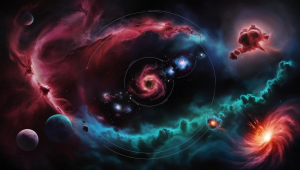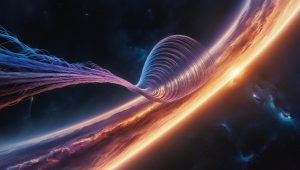
WORMHOLES:COSMIC SHORTCUTS
What if you could rocket from Earth, not to the Moon or Mars, but down a wormhole that loops all the way across the vast Milky Way, slashing travel time
The search for exoplanets– planets that orbit stars outside our planetary system– has actually quickly developed into one of the most interesting and dynamic fields of astronomy. Over the past few decades, advancements in technology and new techniques have dramatically increased the number of known exoplanets, including those that may resemble Earth. These explorations are refocusing our understanding of deep space together with opening new opportunities for the future of space expeditions consisting of the irresistible opportunity of locating life past our planetary system.
The Evolution of Exoplanet Discovery
The initial validated exoplanet, 51 Pegasi b, was found in 1995 utilizing the radial speed technique which spots the mild wobble in a star brought on by the gravitational pull of an orbiting planet. This technique, while efficient, was at first restricted to discovering big, Jupiter-sized planets that orbit near their stars. Nonetheless as discovery strategies enhanced, astronomers started to uncover a much more varied range of exoplanets, consisting of smaller sized, rough planets more comparable to Earth.
Among one of the most substantial improvements in exoplanet exploration included the launch of NASA’s Kepler Space Telescope in 2009. Kepler utilized the transportation approach which includes spotting the small dip in a star’s illumination as a planet passes in front of it. This technique verified very efficiently to bring about the exploration of hundreds of exoplanets, a lot of which remain in the supposed ” habitable area”– the area around a star where problems could be ideal for fluid water, a vital component permanently.
In spite of Kepler’s success, the search for Earth-like exoplanets in the habitable area stays testing. The planets that Kepler discovered were typically away from Earth, making described research challenging. To resolve this, astronomers have actually created brand-new strategies together with modern technologies to enhance the search for exoplanets, particularly those that might possibly nurture life.
New Techniques in Exoplanet Detection
Transportation Spectroscopy: This method entails assessing the light from a star as a planet goes across before it. By researching the adjustments in the star’s light, astronomers can establish the structure of the planet’s environment. This is specifically valuable for recognizing prospective biosignatures– signs of life such as oxygen or methane. The James Webb Space Telescope (JWST), introduced in 2021, is furnished with innovative tools for transportation spectroscopy permitting it to examine exoplanet environments in extraordinary information.
Straight Imaging: Most exoplanets are found indirectly by observing their results on their moms and dad stars. Nevertheless, straight imaging is a technique that catches real pictures of exoplanets by obstructing the light from their star. This method has actually been tested because of the immense illumination of stars contrasted to their planets, yet developments in flexible optics and also coronagraphs have actually made it feasible to straight photo a handful of exoplanets. Future telescopes such as the Nancy Grace Roman Space Telescope aim to boost straight imaging abilities allowing the research of smaller sized, Earth-like planets.
Astrometry: Astrometry includes specifically gauging a star’s placement overhead and also spotting small modifications because of a setting triggered by a tracking planet. This approach is especially conscious of planets that are farther from their stars, making it corresponding to the transportation and also radial speed techniques. The European Space Agency’s Gaia goal, introduced in 2013 is carrying out an astrometric study of the Milky Way, which is anticipated to uncover several brand-new exoplanets.
Gravitational Microlensing: This strategy counts on the gravitational area of a star (as well as its planets) flexing as well as amplifying the light of a history star. When a planet passes in front of the history star, it develops a momentary lighting occasion that can be spotted by telescopes in the planet. Gravitational microlensing is specifically reliable for discovering exoplanets that are farther from their stars or those that orbit low-mass stars. The Roman Space Telescope is anticipated to utilize this strategy to find a great deal of exoplanets, consisting of possibly Earth-like ones.
The Implications for Space Exploration
The exploration of Earth-like exoplanets has extensive ramifications for the future of room exploration. As we determine even more possibly habitable globes, the following rational action is to examine them in better information to establish their possibility permanently. Missions like the JWST along with future room telescopes will certainly play a vital function in this undertaking enabling us to assess exoplanet environments as well as search for indications of life.
Furthermore the exploration of close-by Earth-like exoplanets can at some point result in interstellar expeditions. While present innovation restricts our capacity to take a trip to also the closest stars, principles like the Breakthrough Starshot task purpose to establish small light-propelled spacecraft with the ability of getting to close-by exoplanets within a human lifetime. If effective, such objectives can give mankind’s very first detailed sight of an additional planetary system together with possibly addressing the eternal inquiry of whether we are alone in deep space.
In the much shorter term the research of exoplanets is currently affecting room expedition techniques. For instance recognizing the variety of planetary systems as well as the problems under which earth’s creation together with progress can inform the search for life within our planetary system such as on Mars or the cold moons of Jupiter as well as Saturn.
In addition, the research of exoplanets assists us much better in recognizing our very own planet. By contrasting Earth to various other rough planets in the habitable area, we can obtain understanding right into what makes Earth one-of-a-kind as well as exactly how life could arise together and continue under various problems. This understanding can be very useful as we challenge obstacles associated with environment modification, source monitoring and also the lasting sustainability of human people.
The search for exoplanets is changing our understanding of deep space and also opening brand-new frontiers for expeditions. As brand-new strategies together with modern technologies remain to breakthrough, we are most likely to find much more Earth-like planets, each with its very own capacity to nurture life. These explorations will certainly not just grow our understanding of planetary systems yet additionally motivate future generations to check out the universes searching for brand-new globes as well as, possibly brand-new kinds of life. The search for exoplanets is not simply concerning locating remote planets; it has to do with discovering our location in deep space”.

What if you could rocket from Earth, not to the Moon or Mars, but down a wormhole that loops all the way across the vast Milky Way, slashing travel time

If you go outdoors on a clear evening and also search for it, you might have the ability to see Jupiter beaming brilliantly amongst the celebrities. At the exact same

Stars, the dazzling points of light that fill up the evening skies are the foundation of galaxies plus the cradles of life itself. From their birth in large clouds of

In the mission to recognize deep space mankind has actually developed progressively effective devices to observe deep space. Completion of this venture is the Extremely Large Telescope (ELT) which is

Space debris, also known as space junk, refers to the defunct artificial objects orbiting Earth. These objects include decommissioned satellites, spent rocket stages, and fragments from collisions and explosions.

Gravitational waves stand out as a remarkable finding in today’s universe explorations. Over a century ago Albert Einstein predicted that these waves exist in the fabric of space-time. By generating
Write to
Jasmine Gogoi at csr@scientifictemperament.com
Let’s develop our society with a scientific heart. Join us to build the scientifically nurtured future →